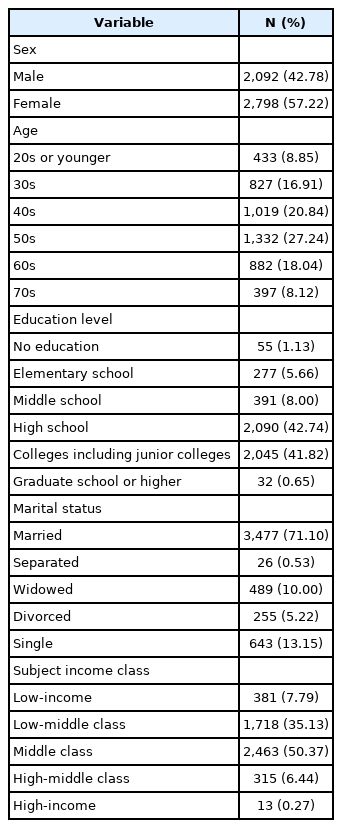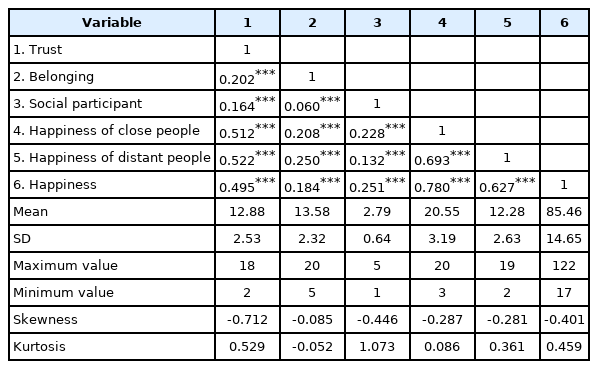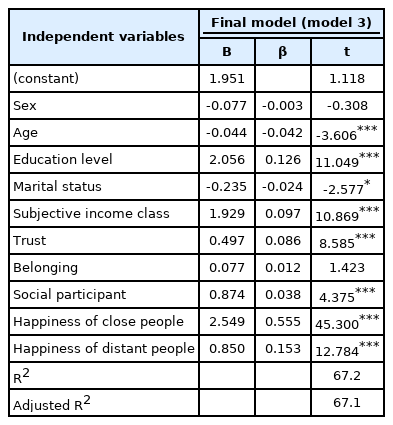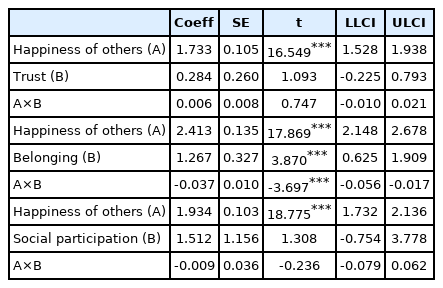The Relationship Between Social Capital, the Happiness of Others, and the Happiness of Korean Adults: A National Sample Study
Article information
Abstract
Objective
This study aimed to reveal the relationship between social capital, the happiness of others, and the happiness of Korean adults.
Methods
Data from 4,890 participants (2,092 males [42.78%] and 2,798 females [57.22%]) aged 19 to 79 years were used. Data used in the analysis were provided by the Survey on Koreans’ Happiness and Quality of Life (2019) conducted by the Korea Institute for Health and Social Affairs.
Results
First, age, education, marital status, and subjective economic level were found to be significantly related to individual happiness. Second, social capital, which including trust and social participation, was positively related to individual happiness. Third, the key result of this study was that the happiness of close people was positively associated with individual happiness. Fourth, belonging showed a significant moderating effect on the relationship between the happiness of others and individual happiness.
Conclusion
This study contributes by examining the relationship between the happiness of others and individual happiness after controlling for social capital and demographic variables and examining the moderating effect of social capital on the relationship between the happiness of self and others. These results are expected to help understand the factors that determine the happiness of Korean adults.
INTRODUCTION
Korea has achieved remarkable economic growth over the past 60–70 years. It joined the Organisation for Economic Co-operation and Development (OECD) in 1996 after rapid economic growth in a short period and ranked 12th worldwide with a GDP of $1,646.3 trillion as of 2019 [1]. However, the happiness index of Koreans is in contrast to this. According to the “World Happiness Report” released by the United Nations (UN), Korea ranked 54th among 156 countries in 2019, ranking very low in happiness level compared to economic level [2]. These results contradict the general social belief that higher economic levels are related to happiness, suggesting that individual happiness is affected by various factors. Happiness, defined as “the state of satisfaction and joy in life,” has become the ultimate goal of all human beings [3]. Hence, research to verify the related variables has steadily progressed [4-7].
Social capital, a major factor affecting happiness, is defined in a wide variety of ways. Coleman [8] noted that it was “a special kind of resource available to any member of society.” Putnam [9] defined it as “a resource available to individuals and groups in a social relationship.” Additionally, Lin [10] also explained that it was “The sum of the resources that can be obtained from social relationships.” The sub-factors of social capital are as diverse, as seen by the definitions, and are typically divided into two components. The first is the cognitive factor, which is subjective and unobservable [11], and includes reciprocity and trust. The second is the structural factor, which is objective and externally observable [11], and includes social participation and networks.
Although there are differences among scholars regarding the factors constituting social capital, there is some consensus that trust and social participation are the key factors [12]. Leonardi et al. [13] saw participation in various social groups as “a central source of social capital.” In addition, since social capital refers to the “capital formed by social participation,” [14] belonging formed by social participation can be considered as a component of social capital. In fact, Ahn and Davis [15] verified this claim.
Previous studies have revealed the relationship between social capital and happiness and reported that social capital was a major factor in predicting individual happiness [6,16,17]. However, the association between happiness and the sub-factors of social capital was not fully integrated. Jo et al. [18] showed that the cognitive factors of social capital had a significant effect on Koreans’ happiness, but the structural factors did not. In contrast, in a study by Jung [17], social trust, a cognitive factor, was not related to happiness, but social network and structural factors had a significant effect on it.
To better predict human happiness, cultural characteristics must also be considered. Korea, a country with a collectivist culture, may have a different concept of happiness compared to countries with an individualistic culture, such as the United States. In general, in an individualistic culture, factors, such as a sense of achievement or positive emotional state, are major variables that predict personal happiness. However, in a collectivist culture, social relationships and social participant have been found to have a major influence [19]. Shin et al. [20] have shown that people from a collectivist culture were more likely to report social words, such as family and love, when they were free to recall words related to happiness compared to those from an individualistic culture. It can be predicted that this is because in a collectivist culture, harmony with people around oneself is important [21,22].
Given these cultural differences, in a collectivist culture, the degree of the happiness of others that individuals perceive may influence their happiness. In collectivist cultures, people are influenced by others in cognitive, emotional, and behavioral aspects as they see themselves as connected rather than separated from others [23]. Choi et al. [24] suggested that the Korean model of happiness included the happiness level of loved ones. In other words, an individual’s level of happiness can vary depending on the level of happiness of others close to them.
Sex and age have a significant impact on individual happiness [25]. Educational level is positively related to happiness [26]. Marital status also has a major impact on personal happiness, and married people have a higher level of happiness compared to unmarried people [27]. Economic level was positively related to happiness, and subjective economic level had a greater effect on individual happiness compared to objective economic level [28]. In particular, it was found that in Korea, the subjective economic level had a greater influence on individual happiness compared to in other countries [5].
This study aimed to examine the relationship between social capital, happiness of others, and individual happiness. The main hypotheses are as follows. First, trust, belonging, and social participation were positively related with happiness. Second, the happiness of others was positively associated with individual happiness.
METHODS
Participants
This study used data from the Survey on Koreans’ Happiness and Quality of Life (2019) conducted by the Korea Institute for Health and Social Affairs (KIHASA). The sampling method used aggregate plotting sampling. A total of 502 aggregates were extracted through the nation’s representative regional unit allocation, and 10 households were extracted from each aggregator. Of these, one household of survey age was randomly investigated [29]. From May 8 to June 13, 2019, trained interviews conducted a survey through structured questionnaires, and a total of 5,020 people participated in this survey. In this study, 130 people with missing age were excluded, 4,890 people (2,092 males [42.78%] and 2,798 females [57.22%]) were used for the final analysis. The participants were adults aged 19 to 79 years. Of the 4,980, 433 (8.85%) were in their 20s or younger, 827 (16.91%) in their 30s, 1,019 (20.84%) in their 40s, 1,332 (27.24%) in their 50s, 882 (18.04%) in their 60s, and 397 (8.12%) in their 70s.
Measures
All measurement tools used were questionnaires developed by the KIHASA.
Happiness
An individual’s level of happiness was measured in 13 areas, that included living standard, health, achievements in life, family relationships, personal relationship (social acquaintances), safety, overall safety in society, future stability, time to do what you like, quality of the community environment, the overall community in which you live, the work you do, and economic level. The following question was asked: “How satisfied are you with the following areas of your life?” The response was rated on a 11-point Likert scale that ranged from 0 (not satisfied at all), 5 (average), to 10 (very satisfied). The higher the summed score, the higher the level of happiness. Cronbach’s alpha (α) for this item was 0.949.
Trust
The degree of personal trust was measured by dividing it into social and interpersonal trust. These were measured by the questions, “Do you think our society is a trustworthy society?” and “How much do you think most people can be trusted?”, respectively. The response was rated on a 11-point Likert scale that ranged from 0 (not satisfied at all), 5 (average), to 10 (very satisfied). The higher the combined score, the higher the level of trust. Cronbach’s α for this item was 0.874.
Belonging
Belonging was measured as a sense of belonging and solidarity felt by an individual. By using the item “I feel a sense of belonging and a sense of solidarity to the place in which I live,” a sense of belonging and solidarity with the Eup/Myeon/Dong, Si/Gun/Gu, City/Province, and the Republic of Korea were measured. A total of five items were used in addition to the question, “I feel like I am a citizen of the entire world where I live.” Responses were rated on a 4-point Likert scale (1=strongly disagree, 2=disagree, 3=yes, 4=very much). The higher the summed score, the higher the individual’s sense of belonging. Cronbach’s α for this item was 0.693.
Social participation
To measure the degree of social participation, a single item was used: “Compared to your peers, how often can you say that you participate in social activities (social gatherings, hobbies, clubs, etc.)?” Reponses were rated on a 5-point Likert (1=much less than peers, 2=somewhat less than peers, 3=similar to peers, 4=somewhat more than peers, 5=much more than peers). The higher the score, the higher the individual’s degree of social participation.
Happiness of others
To measure the level of happiness of others perceived by an individual, the question “How happy do you think the people below are?” was asked. The items were made up of five items that included family, friends, neighbors, Korean citizens, and people worldwide. In this study, analysis was performed by classifying family, friends, and neighbors as close people, and Korean citizens and people worldwide as distant people. The responses were rated on a 11-point Likert scale that ranged from 0 (not at all happy), 5 (average), to 10 (very happy). The higher the summed score, the higher the level of happiness of others perceived by the individual. Cronbach’s α for this item was 0.871.
Statistical analysis
Data analysis was performed using the SPSS version 23.0 (IBM Corp., Armonk, NY, USA) statistical program. Descriptive statistical analysis was conducted to identify the mean (M), standard deviation (SD), skewness, and kurtosis of the demographic and major variables. Correlation analysis was performed to examine the correlation between the variables. Also, a hierarchical multiple regression analysis was conducted to examine the relationships between the variables. Demographic variables, which included sex, age, education level, marital status, and subjective income class, were input in model 1. Trust, belonging, and social participation, which were the components of social capital, were input into model 2. In model 3, the happiness of close and distant others perceived by the individual was inputted. In addition, in this study, moderation analysis using PROCESS Macro 4.0 (Hayes AF, http://processmacro.org/index.html) was performed to examine the relationship between major variables. We wanted to examine the moderation effect of social capital on the association between the happiness of self and others.
RESULTS
Descriptive statistics
Regarding education level, 55 (1.13%) had no education, 277 (5.66%) graduated from elementary school, 391 (8.00%) graduated from middle school, 2,090 (42.74%) graduated from high school, 2,045 (41.82%) graduated from colleges, which included junior colleges, and 32 (0.65%) graduated from graduate school or higher. Regarding marital status, 3,477 (71.10%) were married, 26 (0.53%) were separated, 489 (10.00%) were widowed, 255 (5.22%) were divorced, and 643 (13.15%) were single. The subjective income class consisted of 381 (7.79%) from low-income, 1,718 (35.13%) from low-middle class, 2,463 (50.37%) from middle class, 315 (6.44%) from high-middle class, and 13 (0.27%) from the high-income class. The results are shown in Table 1. For all the variables, the skewness was -1.195 to 1.264, kurtosis was -1.916 to 1.460, and normality was evaluated.
Correlation
Happiness was positively correlated with the happiness of close people (r=0.780, p<0.001) and the happiness of distant others (r=0.627, p<0.001). Happiness was positively correlated with trust (r=0.495, p<0.001), social participation (r=0.251, p<0.001), and belonging (r=0. 184, p<0.001). The results are shown in Table 2.
Hierarchical multiple regression
Results of the hierarchical multiple regression are shown in Table 3. The last model explained 67.2% of the happiness. Sex was not significantly associated with happiness (β=-0.003, p=0.758). Age (β=-0.042, p<0.001) and marital status (β=-0.024, p<0.05) were negatively related to happiness. Education (β=0.126, p<0.001) and subjective income class (β=0.097, p<0.001) were positively related to happiness. This meant that the lower the age, the higher the level of happiness, and those with a spouse were happier compared to those without a spouse. In addition, higher education levels and subjective income classes were positively related with higher happiness. Trust (β=0.086, p<0.001) and social participation (β=0.038, p<0.001) were positively associated with happiness. This meant that higher trust in society and greater social participation were positively related with higher happiness. Belonging was not significantly correlated with happiness (β=0.012, p=0.155). The happiness of others was closely associated with individual happiness. In particular, the happiness of close others had the greatest correlation with individual happiness (β=0.555, p<0.001). This meant that higher happiness of close people, such as family, friends, and neighbors, was positively related to higher individual happiness.
Moderation analysis
The PROCESS Macro (model 1) was used to investigate the moderating effects of trust, belonging, and social participation on the association between the happiness of others and individual happiness. The results are presented in Table 4. To confirm the statistical significance of the moderating effect, the moderator variables were set in three levels (-1SD, M, +1SD), and the significance of a simple regression was verified. Sex, age, education, marital status, and subjective income class were set as the covariate. As a result of examining the moderating effect of social capital on the association between the happiness of others and individual happiness, only belonging was found to be significant and it was found that had a positive effect on individual happiness (t=3.870, p<0.001). The interaction term between the happiness of others and belonging had a negative effect on individual happiness (t=-3.697, p<0.001). The moderating effect was statistically significant at all three levels (-1SD [1.935–2.062], M [1.864–1.963], +1SD [1.758–1.898]), because zero was not included within the 95% confidence interval. That is, the moderating effect of belonging was significant at all levels of happiness of others. Among the variables set as covariates, sex was not significant (t=-0.511, p=0.609), and age (t=-3.402, p<0.01), education (t=12.430, p<0.001), marital status (t=-3.022, p<0.01), and subjective income class (t=13.257, p<0.001) had a significant effect.
DISCUSSION
This study examined the role of social capital and the happiness of others on the happiness of Korean adults. The main results of this study are as follows: First, higher trust and social participation were positively associated with higher happiness. These results were similar to those of previous studies [30]. Additionally, this study reconfirmed that social capital, such as trust and social participation, were important factors that determined the level of happiness of Koreans through a national sample. Fowler and Christakis [31] found that people with high levels of happiness tended to be at the center of social networks. This suggested that more frequent contact with other people and social activities increased individual happiness. More social participation increases the likelihood of receiving instrumental and emotional support from those around. Social support increases individual self-esteem and acts as a buffer against stress [32], which can increase individual happiness. In sum, social capital appears to contribute to enhancing individual happiness by promoting social support.
In this study, belonging was not significantly associated with happiness. However, this result was inconsistent. Previous studies have reported that belonging, a feeling of belonging to own residential community, had a significant correlation with an individual’s happiness [18]. However, this is also a basic human need. In other words, all human beings have the desire to feel a sense of belonging and connection in society [33]. Therefore, belonging act as a necessary condition to increase the level of individual happiness and may not be a sufficient condition by itself.
Second, the happiness of others was found to be closely related to the happiness of Korean adults. In particular, the happiness of close others had the greatest association with individual happiness. Fukushima et al. [34] found through a study of Japanese people that the happiness of others in the same community influenced individual happiness. Considering that Japan also has a collectivist culture like Korea, it can be seen that this was consistent with the results of this study. These results were equally applied not only to close people but also distant people.
Human emotions are directly or indirectly influenced by others [35,36]. This is called “emotional contagion” [37] and refers to experiencing the same emotions as others by imitating other people’s facial expressions and gestures. Similarly, happiness appears to be contagious. Fowler and Christakis [31], through a longitudinal study, revealed that happiness could be diffused to people around oneself through social networks and proved that physical distance had an important influence on the spread of happiness. This means that the closer the distance between people is, the more likely that happiness will spread, and the farther away, the less the effect of the diffusion. In this study, as the happiness of close others had the greatest association on individual happiness, it seemed that the mechanism of “emotional contagion” acted and spread happiness.
Characteristics of Korea’s collectivist culture should also be considered. Individuals in a collectivist culture view themselves as subordinate to the group [38]. Since they see himself as part of the group to which they belong [39], they will be able to internalize the values, norms, status, etc. of the group as their own. Based on this, it can be expected that a group’s happiness level that an individual perceives may influence their happiness.
The happiness shown in collectivist culture is different from that shown in individualistic culture. In collectivist culture, individual happiness can be important in balance with others [40]. Regarding these characteristics, Hitokoto and Uchida [21] suggests the concept of “interdependent happiness” and emphasizes the importance of harmonizing with others and being in a group. It seems that these cultural differences about happiness stem from the differences in self-concepts in each culture. In general, individualistic cultures have an independent self and have a self-concept defined in terms of individual achievement, whereas in collectivistic cultures, they have an interdependent self and have a relational self-concept [41]. Therefore, in collectivism, the happiness of others can be understood as individual happiness.
As age increased, the level of happiness decreased. Similar results were also found in previous studies, which explained that the frequency and intensity of experiencing positive emotions decreased with age [25]. People with higher levels of education were more likely to be happy as they were more likely to have more social capital [42]. People with a spouse were expected to have higher levels of happiness as they experienced more emotional intimacy [43]. A high level of subjective income class may be positively associated with happiness by buffering negative emotions and causing emotional stability [44].
Additionally, as a result of analyzing the moderating effect of social capital on the relationship between the happiness of others and individual happiness to examine the relationship between major variables, only belonging had a statistically significant effect. It is particularly noteworthy that belonging had a positive effect on individual happiness, but the interaction term between the happiness of others and belonging had a negative effect on it. This result can also be understood as a characteristic of collectivist culture. There is a proverb in Korea that says, “When your cousin buys land, your stomach hurts.” This means that when the people around you do well, you feel envy and jealousy, suggesting that the individual makes social comparisons with others. Chung and Mallery [45] (1999) found that the higher the collectivism tendency, the greater the desire to compare oneself with those around them. Kim [46] (2019) suggested that comparison with others weakens happiness. Taken together, Koreans’ collectivistic tendencies can increase their comparison with others who are considered to belong to the same group, which can lead to a decrease in their level of happiness. These results suggest that the cultural characteristics of collectivism and interactions between variables have various effects on the individual’s level of happiness. Therefore, it seems that a follow-up study on this is necessary.
The contributions of this study are as follows: First, the role of social capital in Korean happiness was confirmed. Second, importantly, it was found that the happiness of others had a major association on the happiness level of Koreans adults. In particular, the happiness of close people was the most important variable that determined the level of individual happiness. In general, in individualistic cultures, it has been found that self-focused factors, such as individual achievement and self-actualization, have a great influence on happiness. This shows that it is important to consider cultural factors to better understand individual happiness.
The limitations of this study are as follows. First, social participation was measured using a single item. Therefore, in future research, it will be necessary to measure social participation using more detailed items and reconfirm the relevance of this variable on personal happiness. Second, since this study was conducted as a cross-sectional design, it is difficult to clearly reveal the causal relationship between social capital, the happiness of others, and individual happiness.
Notes
Availability of Data and Material
The datasets generated or analyzed during the current study are available in the Korea Institute for Health and Social Affairs repository (https://data.kihasa.re.kr/kihasa/kor/contents/ContentsList.html).
Conflicts of Interest
The authors have no potential conflicts of interest to disclose.
Author Contributions
Conceptualization: Jo-Eun Lee, Sung-Man Bae. Formal analysis: Jo-Eun Lee, Sung-Man Bae. Project administration: Sung-Man Bae. Supervision: Sung-Man Bae. Writing—original draft: Jo-Eun Lee. Writing—review & editing: Jo-Eun Lee, Sung-Man Bae.
Funding Statement
This research received no specific grant from any funding agency in the public, commercial, or not-for-profit sectors.
Acknowledgements
We would like to thank Editage (www.editage.co.kr) for English language editing.




